연기 흡인, 연기 흡인 화상, 화재, Smoke inhalation, Inhalation burn, Fire
연기 흡입의 개요
-
화재가 난 장소에 있었던 사람은 뜨거운 연기, 일산화탄소, 독성 가스 등을 기도 내로 흡입할 수 있다.
-
산소부족으로 질식될 수 있고,
-
일산화탄소 중독이 생길 수 있고,
-
화재에서 나온 열기로 피부 열화상을 입을 수 있고
-
기도 점막층 흡입 열화상을 입을 수 있다. 정도가 심하면 질식, 사망 할 수 있다.
-
특히 다세대 주택이나 밀집 상가 건물 화재에서 생긴 뜨거운 공기, 낮은 산소 농도 공기를 흡입할 때 질식될 수 있고 기도의 점막층이 심하게 델 수 있다.
-
옷, 가구, 카펫, 매트레스 등 화학물질이 탈 때 생긴 독성 가스를 흡입해서 독성 가스 중독으로 사망할 수 있다.
-
뜨거운 연기를 흡입해 비강, 인두, 후두, 기관, 기관지의 기도의 점막층과 폐포가 흡인성 열화상을 입을 수 있다.

▴ 사진 1-19. 화재경보기를 집안에 설치해 놓는다.
Copyright ⓒ 2011 John Sangwon Lee, MD., FAAP
-
기도 점막이 붓고 흡입성 화상성 폐렴, 흡입성 화학물질 폐렴이 생길 수 있다.
-
흡입성 화상성 폐렴이 생기면 기도 점막층이 붓고 기도가 좁아지고 가래가 끓고 기침 하면서 숨이 차고 호흡곤란이 생길 수 있고 질식 될 수 있다. 일산화탄소 중독사고 예방 참조.
연기 흡입의 증상 징후
-
화재 현장에서 뜨거운 연기를 얼마나 오랫동안 흡입했는지, 독성 가스가 얼마나 생겼는지, 독성 가스를 얼마나 오랫동안 흡입했는지, 피부와 기도의 점막층에 생긴 열화상의 정도에 따라 증상 징후가 다르다.
-
화재가 난 장소에 있었던 환아가 구출된 직후 처음 몇 시간 동안 기침을 거의하지 않고 거의 정상으로 호흡하다가도 그 후 불과 몇 시간 후 심하게 기침하면서 몹시 가쁘게 숨 쉬면서 호흡곤란이 심해 질 수 있다.
-
뜨거운 연기와 독성 가스 등을 흡입하면 기도 점막층과 폐포가 열화상 및, 또는 독성 가스로 손상될 수 있고, 심하면 전신 청색증이 생기고 폐가 붓고 폐출혈로 사망할 수 있다.
-
특히, 플라스틱 화학물질이나 그 외 다른 종류의 화학물질이 탈 때 생긴 독성 가스를 흡입하면 순식간에 질식될 수 있고 사망할 수 있다.
-
독성 가스의 종류에 따라 기도의 점막층과 폐포가 손상되는 정도가 다르다.
-
화재로 생긴 고 농도 일산화탄소를 흡입하면 기도의 점막층이나 폐포가 손상되지 안치만 일산화탄소 중독으로 사망할 수 있다.
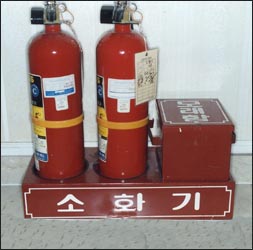
▴ 사진 1-29. 평소에 소화기를 집안에 설치하고, 수시로 제대로 작동하는지 점검하고 화재가 났을 때 쓰는 법도 알아둔다.
Copyright ⓒ 2011 John Sangwon Lee, MD,, FAAP
화제 연기 흡입의 치료
-
화재가 났던 장소에 있었던 사람들의 피부와 기도의 점막층에 화상을 입을 수 있다.
-
독성 가스를 흡입해 독성 가스 중독, 일산화탄소 중독이 생길 수 있다.
-
나이, 화상의 크기와 정도, 독성 가스 중독 및, 또는 일산화탄소 중독의 정도에 따라 치료한다.
-
화재 연기를 흡입했을 때 일반 응급 치료법에 관해 설명하면
-
화재가 난 장소에서 안전한 장소로 환아를 우선 옮긴다.
-
의료구급대, 병원 응급실, 단골 소아청소년과, 또는 소방서의 전화 진료 지시에 따라 응급치료를 현장에서 시작한다.
-
화재가 난 장소에 있던 환아의 피부에 열화상이 생기지 않았더라도 환아는 뜨거운 연기, 독성 가스, 일산화탄소를 흡입했다고 추정하고 호흡기 화상, 일산화탄소 중독, 독가스 중독에 관한 응급치료를 시작한다.
-
초진에서 피부 열화상을 입지 않고 독성 가스 중독의 증상 징후가 없어도 의사의 적절한 추적 치료를 받는다(화상 참조).
-
화재가 났을 때 뜨거운 연기나 독성 가스를 흡입한 환아가 화재가 난 바로 후 초진을 받을 때는 아무 이상이 없을 수 있다. 그 후 몇 시간이 지난 후부터 약 24시간 이내에 심한 화상성 폐렴이 생길 수 있다.
-
특히 화재로 얼굴이나 목 부위 피부에 열화상을 입은 환아의 대부분은 뜨거운 연기를 흡입했을 가능성이 많고 기도 점막층 열화상을 입었을 가능성이 많다. 그런 이유로 그에 따른 적절한 치료를 받아야 한다.
-
화재로 후두가 많이 데었을 때는 후두 부분 기도가 붓고 가래가 나오고 금방 목이 쉴 수 있다. 이때 후두 부분 기도가 빨리 막혀 사망할 수 있다.
-
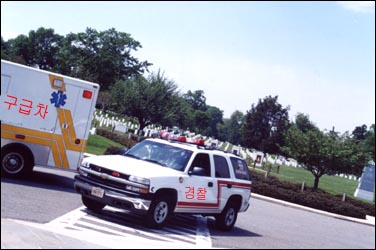
▴ 사진 1-21. 필요에 따라 의료구급대, 구급차를 부른다.
Copyright ⓒ 2011 John Sangwon Lee, MD., FAAP
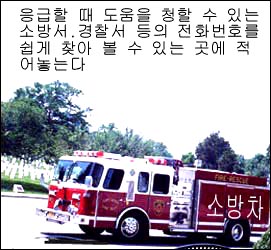
▴사진 1-22. 필요에 따라 소방차를 부른다.
응급의료 상황에서 도움을 얻을 수 있는 소방서, 경찰서, 병원 응급의료 센터의 전화 번호를 쉽게 찾아 볼 수 있게 적어 놓는다
Copyright ⓒ 2011 John Sangwon Lee, MD., FAAP
-
열화상으로 기도 점막층이 손상되고 호흡곤란이 심하게 생길 때는 기관 절개수술로 임시 숨구멍을 만들어 임시 숨구멍을 통해 숨을 쉬게 치료한다.
-
이런저런 이유로 화재가 난 장소에서 뜨거운 연기를 흡입한 환아의 목이 쉬거나 호흡곤란이 생길 때는 가까운 병원 응급의료 센터로 급히 데리고 가 적절한 응급치료를 받아야 한다.
-
화학섬유 옷에 불이 더 쉽게 붙어 열화상을 입을 수 있다. 특히 불에 잘 타는 옷을 평소에 어린이들에게 입히지 말아야한다.
-
입은 옷에 불이 붙으면 불붙은 쪽을 방바닥이나 흙바닥에 대고 눕게 하거나 뒹굴게 해서 옷에 붙은 불을 끄든지, 물을 끼얹든지, 젖은 담요 등으로 타는 옷을 덮든지 소화기를 이용해서 불을 끈다.
-
타다 남은 옷을 가위나 칼로 잘라 벗긴다.
-
피부 열화상을 입은 바로 후 얼음물 주머니나 찬물 주머니로 피부 열화상 상처에 찬찜질을 하든지, 화상을 입은 신체 부위를 얼음 덩어리 물속에 잠시 동안 담그면 덜 아프고 덜 붓는다.
-
상황에 따라, 화상의 정도에 따라 의료구급대, 병원 응급실, 또는 단골 소아청소년과의 전화진료 지시에 따라 병원 응급실로 빨리 데리고 가야 한다.
-
호흡기와 피부에 생긴 열화상의 정도, 독성 가스 중독의 정도에 따라 응급치료를 하면서 필요에 따라 항생제, 파상풍 백신 예방접종, 수혈, 전해질용액 정맥 주사, 산소호흡, 심폐 소생술, 코르티코스테로이드제, 진통제 등으로 치료한다.
화재 예방
-
영유아들이 성냥이나 라이터 등으로 불장난을 하면서 놀지 않도록 주의하고 화재를 낼 수 있는 성냥갑이나 발화물질을 안전한 장소에 보관한다.
-
집안에서 화재가 났다고 가정하고 화재가 날 때 소아청소년 자녀가 안전하게 대피하는 방법을 평소에 전식구가 다 함께 연습한다.
-
호텔이나 낯선 곳에 투숙할 때 화재가 나면 안전하게 대피하는 방법을 미리 알아보도록 교육시킨다.
-
잠옷이나 평소에 입는 옷은 불이 잘 붙지 않고 잘 타지 않는 것으로 선택한다.
-
어린이들이 담뱃불, 성냥불, 또는 라이터 불을 가지고 놀지 않도록 주의 한다.
-
침실에서 담배를 절대로 피지 말아야 한다.
-
부엌에서 뜨거운 냄비 등을 스토브에서 옮길 때 쓰는 요리용 장갑은 불이 붙지 않는 재료로 만들어야 한다.
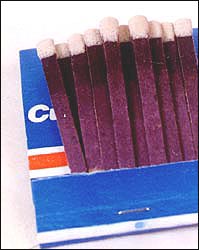
▴ 사진 1-23. 성냥갑을영유아들의 손에 닿지 않게 잘 보관한다.
Copyright ⓒ 2011 John Sangwon Lee, MD., FAAP
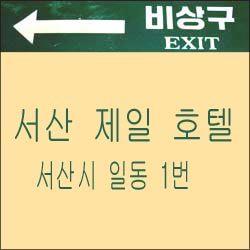
▴ 사진 1-24. 호텔 등 낫선 곳에 투숙할 때
화재나 응급의료 상황에 대비해서 안정하게 대피 할 수 있는 비상구가 어디에 있는지 알아놓는다.
Copyright ⓒ 2011 John Sangwon Lee, MD., FAAP
-
화재경보기를 집안에 설치해 화재가 날 때는 화재가 난 장소에서 안전한 장소로 탈출해 화상을 입지 않게 예방교육을 시키고 실제로 주기적으로 예방교육을 시킨다.
-
불이 날 때 빨리 끌 수 있는 소화기나 스프링클러 장치 설치도 고려해 본다.
-
화재로 탄 건축 재료에서 생긴 가스가 인체 건강에 해로운 독성가스이면 그런 건축 재료로 건축해서는 안된다. 부모도 반의사가 되어야 한다–제2권 소아청소년 질병 안전사고 예방–화상 사고 예방 참조.
Smoke inhalation, Inhalation burn, Fire
Overview of smoke inhalation
- Anyone who has been in the area of a fire can inhale hot smoke, carbon monoxide, and toxic gases into the airways.
- It can be suffocated due to lack of oxygen,
- Carbon monoxide poisoning can occur,
- The heat from the fire can cause thermal burns of the skin.
- Inhalation of hot air may result in thermal burns of the mucous membrane of the airways.
- Severe severity can lead to suffocation and death.
- In particular, when inhaling hot air or low oxygen concentration air from a fire in a multi-family house or a building in a crowded building, it may cause suffocation, and the mucous membrane of the airways may bleed severely.
- Toxic gas poisoning can result in death by inhaling toxic gases produced by burning chemicals such as clothes, furniture, carpets, and mattresses.
- Inhalation of hot smoke can cause aspiration thermal burns of the mucous membranes and alveoli of the airways of the nasal cavity, pharynx, larynx, trachea, and bronchi.

▴ Photo 1-19.
Install fire alarms in your home.
Copyright ⓒ 2011 John Sangwon Lee, MD., FAAP
- · Swelling of the airway mucosa can lead to inhaled burn pneumonia and inhalable chemical pneumonia.
- When inhaled burn pneumonia occurs, the mucous membrane of the airway is swollen, the airway narrows, sputum boils, coughing, shortness of breath, and suffocation. See Prevention of Carbon Monoxide Poisoning Accidents.
Symptoms, signs of smoke inhalation
- Symptoms differ depending on how long the hot smoke was inhaled at the fire site, how much toxic gas was produced, how long the toxic gas was inhaled, and the degree of thermal burns in the mucous membrane of the skin and airways.
- The child who was in the place of the fire may cough for the first few hours immediately after being rescued and breathe almost normally, but only a few hours after that, coughing violently and breathing very quickly, resulting in severe breathing difficulties.
- Inhalation of hot smoke and toxic gases can damage the mucous membranes of the airways and alveoli with thermal burns and toxic gases, and in severe cases, systemic cyanosis, swelling of the lungs, and pulmonary bleeding can lead to death.
- In particular, inhalation of toxic gases produced by burning plastic chemicals or other types of chemicals can lead to rapid suffocation and death.
- Depending on the type of toxic gas, the degree of damage to the mucous membranes and alveoli of the airways varies.
- Inhalation of high concentrations of carbon monoxide from a fire does not damage the mucous membranes or alveoli of the airways but can lead to death from carbon monoxide poisoning.
▴ Photo 1-29.
Install a fire extinguisher in your house, check if it works properly, and know how to use it in case of fire. Copyright ⓒ 2011 John Sangwon Lee, MD., FAAP
Treatment of smoke inhalation
- People who were in the place of the fire can burn their skin and mucous membranes of the airways.
- Inhalation of toxic gas can lead to toxic gas poisoning and carbon monoxide poisoning.
- Treatment depends on age, the size and severity of burns, toxic gas poisoning, and/or carbon monoxide poisoning.
- Explaining common first aid treatments for inhaling fire smoke
- First, move the child from the fire to a safe place.
- Emergency treatment is initiated on-site by following telephone instructions from a medical paramedic, hospital emergency room, regular pediatrics department, or fire department.
- Even if there is no thermal burn on the skin of the patient in the place of the fire, the child is assumed to have inhaled hot smoke, toxic gas, and carbon monoxide, and emergency treatment for respiratory burns, carbon monoxide poisoning, and poison gas poisoning is initiated.
- Even if your child does not suffer from skin thermal burns at the first visit and there are no signs of symptoms of toxic gas poisoning, seek appropriate follow-up by a doctor (see burns).
- In the event of a fire, there may be no abnormalities when a patient who inhales hot smoke or toxic gas receives a first examination immediately after the fire.
- After a few hours, severe burn pneumonia can develop within about 24 hours.
- In particular, most of the children who suffered thermal burns on the skin of the face or neck due to fire were more likely to have inhaled hot smoke and suffered thermal burns of the mucous membrane layer of the airways.
- For that reason, your child should seek appropriate treatment accordingly.
- When the larynx is burned a lot by a fire, the airways in the larynx are swollen, the phlegm may come out, and the throat may rest quickly. At this time, the airway in the larynx region can be quickly blocked and death can occur.
▴ Photo 1-21. Call a medical paramedic or ambulance if necessary. Copyright ⓒ 2011 John Sangwon Lee, MD., FAAP
▴Picture 1-22. Call fire engines as needed.
Write down phone numbers for fire departments, police departments, and hospital emergency medical centers where you can get help in an emergency medical situation so you can easily find them.
Copyright ⓒ 2011 John Sangwon Lee, MD., FAAP
- When the mucous membrane layer of the airway is damaged by thermal burns and breathing difficulties occur severely, a temporary breathing tracheostomy is created to breathe.
- For one reason or another, when a child who inhales hot smoke in a fire place has a sore throat or has difficulty breathing, he or she should be taken to the nearest hospital emergency medical center for appropriate emergency treatment.
- Chemical fiber clothing can catch fire more easily and cause thermal burns. In particular, don’t wear clothes that burn easily on children.
- If your child’s clothes catch on fire, put the lit side down on the floor or on the dirt floor to extinguish the fire, pour water, cover burning clothes with a wet blanket, etc., or use a fire extinguisher to extinguish the fire.
- Cut off the leftover clothes with scissors or a knife.
- Immediately after a skin thermal burn, apply a cold water compress to the skin thermal burn with an ice water bag or a cold water bag, or immerse the burned body in ice cubes for a while to make it less painful and less swelling.
- Depending on the situation, depending on the severity of the burn, you need to take it to the hospital emergency room as soon as possible according to the medical emergency department, hospital emergency room, or phone call instructions from your regular pediatrician.
- Depending on the degree of thermal burns on the respiratory and skin, and the degree of toxic gas poisoning, emergency treatment is provided, and if necessary, antibiotics, tetanus vaccination, blood transfusions, intravenous electrolyte solutions, oxygen resuscitation, cardiopulmonary resuscitation, corticosteroids, pain relievers, etc.
Fire prevention
- Be careful not to let infants and toddlers play while playing with matches or lighters and keep matchboxes or ignitable materials that can catch fire in a safe place.
- Assuming that there is a fire in the house, all household members practice together on how to safely evacuate children and adolescents in the event of a fire. In the event of a fire while staying in a hotel or a strange place, teach them to know how to safely evacuate.
- Choose pajamas or clothes you usually wear that don’t ignite well and do not burn well.
- Be careful not to let children play with cigarettes, matches, or lighter fires.
- Never smoke in the bedroom.
- Cooking gloves used to move hot pots from the stove in the kitchen
- should be made of non-flammable materials
▴ Picture 1-23. Keep matchboxes out of reach of infants. Copyright ⓒ 2011 John Sangwon Lee, MD., FAAP
▴ Picture 1-24.
- When staying in a stranger place such as a hotel
- Find out where there are emergency exits where you can safely evacuate in case of a fire or emergency medical situation. Copyright ⓒ 2011 John Sangwon Lee, MD., FAAP
- Fire alarms are installed in the house to prevent burns by escaping from the fire to a safe place when there is a fire, and preventive training is actually provided regularly.
- Consider installing a fire extinguisher or sprinkler system that can quickly turn off fires.
- If the gas generated from a building material burnt in a fire is a toxic gas that is harmful to human health, such building material should not be used.
- Parents should also be at least a half-doctor-see Volume 2 Prevention of Child and Adolescent Disease Safety Accidents-Burn Accident Prevention.
출처 및 참조 문헌 Sources and references
- NelsonTextbook of Pediatrics 22ND Ed
- The Harriet Lane Handbook 22ND Ed
- Growth and development of the children
- Red Book 32nd Ed 2021-2024
- Neonatal Resuscitation, American Academy Pediatrics
-
Childhood Emergencies in the Office, Hospital and Community, American Academy of Pediatrics
-
Emergency Medical Service for Children, By Ross Lab. May 1989. p.10
-
Emergency care, Harvey grant, and Robert Murray
-
Emergency Care Transportation of Sick and Injured American Academy of Orthopaedic Surgeons
-
Emergency Pediatrics A Guide to Ambulatory Care, Roger M. Barkin, Peter Rosen
-
Immediate care of the acutely ill and injured, Hugh E. Stephenson, Jr
-
The Critically Ill Child, Diagnosis and Management, Edited by Clement A. Smith
-
Emergency Medical Services for Children: The Role of the Primary Care Provider, America Academy of Pediatrics
-
Quick Reference To Pediatric Emergencies, Delmer J. Pascoe, M.D., Moses Grossman, M.D. with 26 contributors
-
Manual of Emergency Care 응급환자관리 정담미디어
-
소아가정간호백과–부모도 반의사가 되어야 한다, 이상원
-
Neonatal Resuscitation American heart Association
-
Neonatology Jeffrey J.Pomerance, C. Joan Richardson
-
Pediatric Resuscitation Pediatric Clinics of North America, Stephen M. Schexnayder, M.D.
-
Pediatric Critical Care, Pediatric Clinics of North America, James P. Orlowski, M.D.
-
Preparation for Birth. Beverly Savage and Dianna Smith
-
Nelson Textbook of Pediatrics 14th-21st ed. Beherman,
-
The Johns Hopkins Hospital, The Harriet Lane Handbook, 18th edition
-
Red book 29th-31st edition 2021
-
Nelson Text Book of Pediatrics 19th Edition
-
Infectious disease of children, Saul Krugman, Samuel L Katz, Ann A. Gershon, Catherine Wilfert
-
The Harriet Lane Handbook 19th Edition
-
소아과학 대한교과서
-
제1권 소아청소년 응급의료 참조문헌과 출처
-
Other
Copyright ⓒ 2015 John Sangwon Lee, MD., FAAP
“부모도 반의사가 되어야 한다”-내용은 여러분들의 의사로부터 얻은 정보와 진료를 대신할 수 없습니다.
“The information contained in this publication should not be used as a substitute for the medical care and advice of your doctor. There may be variations in treatment that your doctor may recommend based on individual facts and circumstances. “Parental education is the best medicine.”